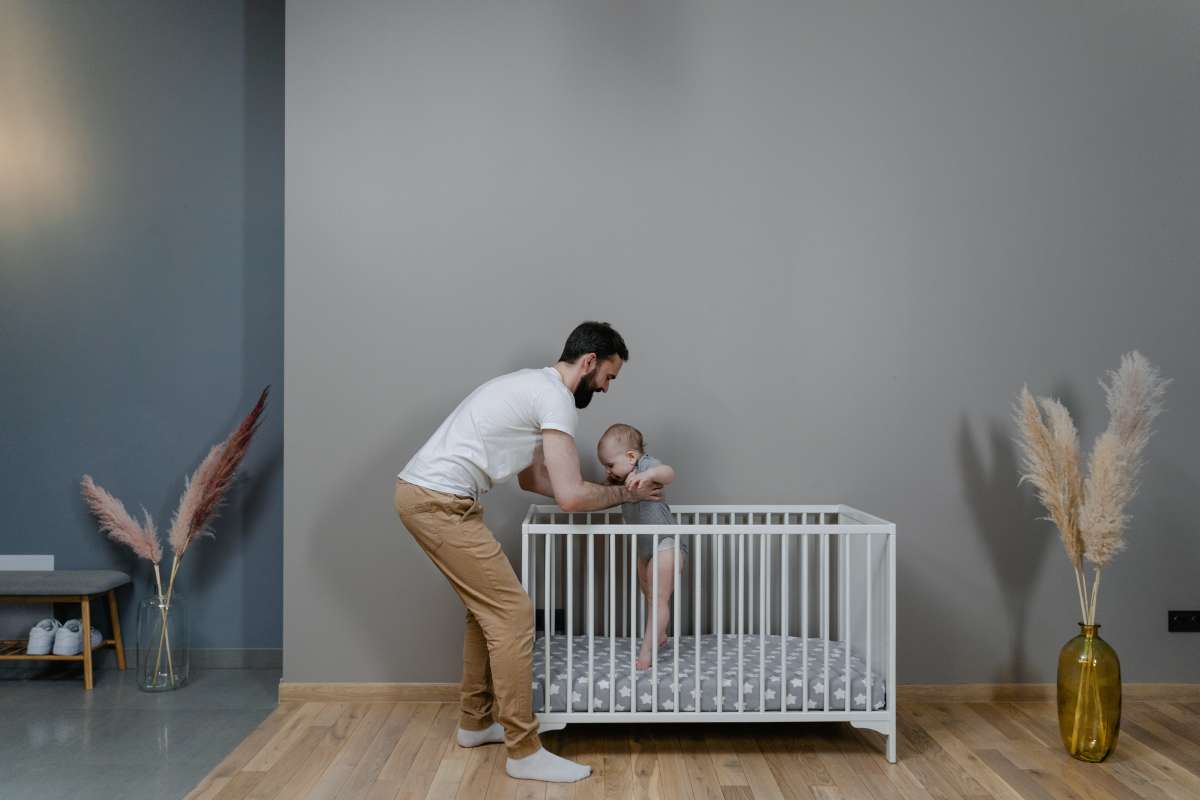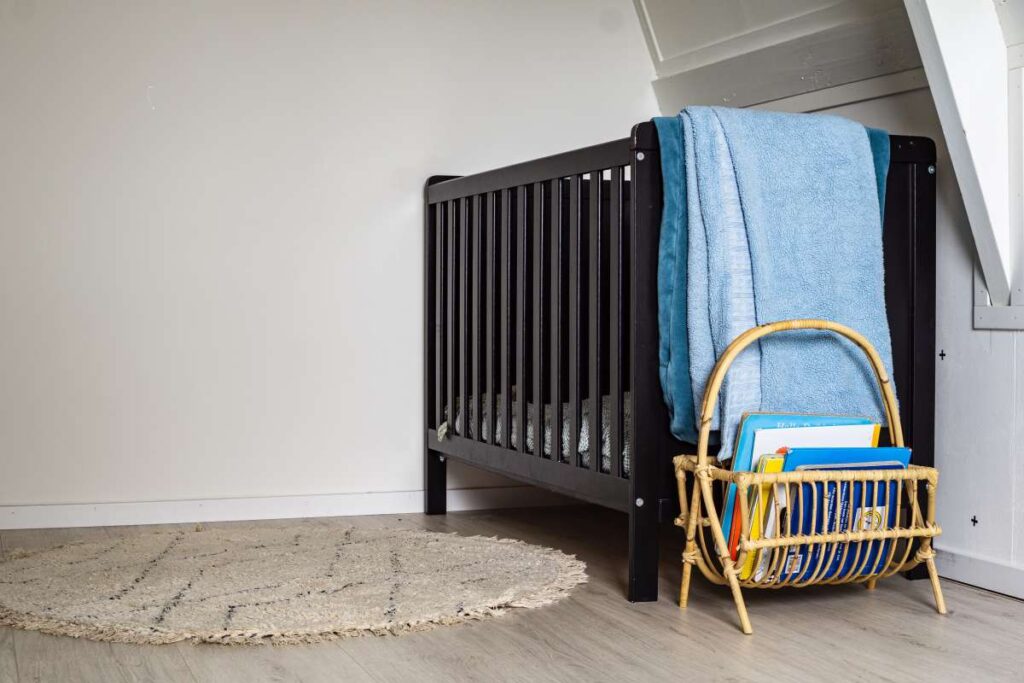Learning how to stand up while in the crib is a necessary rite of passage. When your child masters this ability, they will likely refuse to go to sleep and instead insist on practising it in their crib.
It's important to first acknowledge and appreciate this growing up period. While this is an important step forwards, we understand that it will cause you some frustration. Your baby will gain weight and muscle quickly in the first year, and before you realise it, they may be running circles (or even laps) around you.
Most kids have a hard time lowering themselves back down from a pull-up bar once they've mastered using it. It's not uncommon for parents to engage in an endless power struggle with their sleeping child, which involves the youngster standing up as they're being laid down, and the child immediately sitting back up.
Baby wants to practise, practise, and practise some more when he or she is learning anything new. Babies often like to engage in this activity when lying in their cots for naps or nighttime sleep.
While it's frustrating when it happens, this is actually a positive sign that they're learning and eager to do better at their new ability.
Standing in the cot might serve a different purpose for older infants and toddlers who have long since mastered the art of standing. If they aren't weary yet, they might not be ready for a nap or bedtime.
Even if they are exhausted and ready for bed, they may be unwilling to give in to sleep due to a case of fear of missing out (FOMO).
Because every kid is unique and progresses at their own pace, the desire to practise standing might strike at any age. It can occur as early as six months of age or as late as ten months of age or older.
Don't panic if your baby never stands in his or her cot; some newborns only do this when they're awake.
Don't stress too much about your baby reaching certain milestones at very certain ages; instead, have faith that he or she will develop normally and in their own time.
You can give them a chance to try out new abilities and let them progress at their own pace. Talk to your doctor, health care provider, or paediatrician if you have any worries about your child's growth and development.
A baby or toddler who is able to pull up on the side of their cot may begin to do so at any time:
- It could be a sign that they're ready for a change in their schedule and the times they go to bed and wake up.
- If there has been a major shift in their lives, such as starting nursery school or relocating to a new home, they may feel anxious and require additional reassurance before sleep.
- They might start standing up because they want to practise other skills they've just learned, like talking or walking.
- The phrase "only a phase" can also apply. Young children, like the rest of us, experience ebbs and flows of emotion and development.
FAQs About Baby Crib
Try to unlock her hand and encourage her to lie down. Once she lies down, rub her back a little bit more than you think you should to encourage her to stay lying down. Would recommend you sit by the crib and, when she starts picking herself up, say, “Shh-shh-shh. Night-night,” and encourage her to lie back down.
On average, babies start standing in the crib during the eight-month sleep regression. This is when babies become much more mobile, in general. Some babies might learn the skill early, around 6 to 7 months old, while others might not learn until 9 to 10 months old.
Try lots of reassurance: 1) Talk quietly and cuddle your baby until calm 2) Put your baby on their back in the cot awake (drowsy) 3) Comfort your baby with gentle 'ssshh' sounds, gentle, rhythmic patting, rocking or stroking until a baby is calm or asleep.
As always, lay your baby down in the crib while drowsy. If the baby cannot self-soothe, offer verbal soothing or tummy rubbing until your little one is calm. Keep the room dark, and try not to pick up your baby. You can continue going in every 5 to 10 minutes as needed until the baby falls asleep.
If you're laser-focused on instilling good sleep habits and teaching your baby to fall asleep and stay asleep without too much intervention on your part, then yes, the experts say to put your baby in their crib fully awake and teach them to fall asleep independently.
How Can You Help Them Sleep When They Keep Standing Up

The time spent standing in the cot, like many other developmental stages, is usually short and you will emerge on the other side in a matter of days or weeks. While we can't make our toddlers sit down, the following advice may be helpful as they move through this stage:
- Practice. Most children learn to stand before they can get themselves back to a sitting or sleeping position on their own. When they are awake, you can assist them in practising this. When they are upright, put toys on the ground so they can practise bending down to pick them up. You can assist them in bending their knees so they can reach for a favourite book or toy.
- Review sleep timings. If they are waking up feeling unusually alert, it may be time to have them stay awake for extended periods of time between naps or perhaps cut back on their daily sleep. If your child is standing in the crib or fighting sleep, it may be an indication that their current schedule needs adjusting.
- Couldn't you make it into a war or a game? Try to refrain from repeatedly laying down your child if he or she continues getting up from the cot. It's not just the people involved who might find it exhausting or irritating. If they keep getting up when you lay them down, that's not the best option. Once they have settled down, you can leave the room. You might also sit next to the crib when you put them to sleep and tap the mattress to indicate that it's time for them to go to sleep.
- Consider getting a sleeping bag. You may sleep soundly without worrying about your blankets flying off when you get up if you switch to a sleeping bag, which you may want to consider if you haven't already.
- Provide boundaries. The best way to help our young children through this is to set some firm yet kind limits by reminding them that bedtime has arrived. Assist them in falling back asleep by seeing to their immediate needs (making sure they're not hungry, uncomfortable, in need of a nappy change, etc.). Staying with them, even if they haven't needed it before, or giving them some time and space to calm down on their own, are also options.
- Be patient. It may be difficult to remember this at the moment, but this is just a phase. This can take some time and patience, as you'll want to send clear signals that the only thing going on right now is the relaxed preparation for sleep.
- Couldn't you push it? Short sleepers may be repositioned from sitting or standing to lying down. If it's obvious that they won't go back to sleep after being awakened, then it's time to move on.
Just take a breath and consider what could be motivating your standing. Help them calmly practise new abilities, adjust their routine if you think it's appropriate, and get to sleep when you know they're ready.
Prevent My Child From Standing Up In The Cot.
Getting through the initial stages of sleep training is a major accomplishment. Putting your kids to bed early and making sure they stay asleep for eight hours may be a real challenge.
Also, you may see that your kid is having erratic sleep habits that shift from day to day. During the night, it's not uncommon to see kids sitting up straight on their cots, gripping the bars for dear life.
Helping Your Baby Sleep At Night
If you've noticed that your baby stands up during sleep or nap time, it's probably because he or she has discovered something new and is too enthusiastic to go back to sleep or nap.
When this occurs, individuals become irritable since they haven't had enough rest. Your own stress levels and lack of sleep may increase during this time, and if you lose your temper, your child may resist being set down.
As soon as your baby stands up in their crib, you should lay them back down on the mattress and leave the room. Keep from going to sleep just yet and make sure your kid is okay. Keep them lying down for a while and check on them every few minutes; if they get up again, put them back down.
Keep your distance and don't remain too long once you've gotten your child to lie down.
Tips For Getting The Baby To Lying Down
If your kid fights you every step of the way to the floor, and even clings to the bars for dear life, you'll need to find creative ways to convince them to sit down.
What follows is a list of fantastic suggestions.
- As a parent, you can take a break and try again if your child still clings to the cot's sides after you've given them some space.
- If they persist in being difficult, you should give them space for a while. Antagonising the situation can only lead to further trouble.
- Your youngster will get sleepy and realise why they need to lie down if you just wait long enough.
- If your child has trouble falling asleep in the morning, you might try showing them how to lie down on their own.
- This will help them get used to the behaviour, and if they ever get up, they will naturally try to lie back down in the position you taught them.
- Singing to your child as you instruct them to lie down can be a great way to boost their confidence and motivation. Singing "Ring Around the Rosie" is a fun way to get kids in the mood. Hold your child's hand as you sing, and when you get to "Ring around the Rosie... and we all fall," you can gently put them on their bottom.
- Your kid will enjoy the activity, and they'll be more likely to give it a go on their own afterwards. In certain cases, you may need to wait up to two weeks before seeing any improvements. Alternatively, you may use games.
- A soothing song or sweet words spoken at bedtime will help put your youngster to sleep. Once they are lying down, you can lull them to sleep by gently stroking their face or back.
- Keep in mind that this can help children learn to sleep on their own if you cease doing it at bedtime.
- Nap times can be cut shorter and free play and standing time given. Your child will have a restful night's sleep once bedtime arrives.
- My infant had a much easier time drifting off to sleep after a night of swimming for half an hour, and she sleeps through the night with much less likelihood of waking up.
- In order to make your baby's nursery a more restful place for naps and overnight stays, you can try redecorating it. Between the ages of six months and a year, your child's senses are at their peak.
- Make your child's senses feel confused and drowsy, and they won't be able to resist going to sleep. Adjust the temperature, draw the drapes, and turn off the spotlights.
- Make sure you have everything you'll need for a comfortable night's sleep in your room before your child's bedtime and try to avoid going in there while he or she is attempting to get to sleep.
- A white-noise generator or music box is another option. Your child may fall asleep to the humming or the gentle song.
- Aside from putting your child on a nighttime adventure, changing the look of their cot might help lull them to sleep.
- In order to keep them entertained in the crib, you can use a net or portable toys. A glider is another option for soothing your infant to sleep. Make sure your baby is at least six months old before he or she has toys in the cot.
- The use of a baby sleeping bag can also help limit the baby's movement as they sleep. Since their legs will be restrained by the sleeping sack, this can also help keep them in position.
- Finally, you may let your breastfeeding infant share your bed with you at night.
Babies that co-sleep with their moms and are breastfed at the same time have been shown to sleep for longer stretches of time. It lessens the possibility that your kid will stay on the tracks when given the opportunity. If they come to bed with you, you can keep an eye on them and make sure they get enough rest.
Until Now, Things Had Settled Down!

A moment later, your baby is standing up in their crib, beaming, and refusing to go to sleep. They complete a sleep cycle, then immediately stand up.
Ping!
When it's time for a nap, you can just drop them into bed and wake them up when they're ready. Like a jack in the box, you're upright and not dozing off.
Mom is feeling aggravated. The infant is becoming very exhausted. In what way may this problem be fixed? Don't worry, your infant is just going through a natural stage of development.
All newborns go through a period of sleep regression when they reach the physical milestone of learning to stand; this can be overcome by teaching your child to resume lying down after standing.
You may feel inclined to "make" your kid sleep if he or she isn't sleeping through the night and you're feeling frustrated.
A 10-month-old baby cannot be "put to sleep," unfortunately. They might go to sleep if you feed them or rock them.
However, putting a baby to sleep against his or her will at this age frequently ends in tears, a later bedtime, and more wakings during the night.
Instead, we should do everything we can to help our babies feel secure and cared for when they give in to their exhaustion and drift off to sleep.
Your baby may need to be physically laid down in their cot if they are getting to the point when they are falling asleep while standing up or becoming very unhappy.
They are not being compelled to lie down and stay that way or go to sleep. You and the infant will end up crying if you do it.
It's only a 'physical indication' to let them know it's bedtime and they should be sleeping. They have to take a nap.
We know we are making an impact and altering the circumstance when they immediately snap back up, sometimes even becoming irritated with us.
It's up to you, the parent, to figure out whether your kid would respond better if you lay them down at regular intervals or whenever they got up. You, as a parent, know your kid best and can anticipate his or her needs.
Although you may feel frustrated after 30 minutes or more of trying to get your child to sleep, remember that you are not actually pushing or helping your child to sleep.
You have created a soothing space, ensured a full stomach, and gotten your child to bed on time. No one expects you to sleep or to put your infant to sleep against his or her will. Your infant must learn to self-soothe by succumbing to sleepiness.
The wait will be worth it. Remember how difficult this is for your baby. Weary and aggravated, they are trying to master the art of decompressing.
You could try singing or chatting to them in a soft, comforting voice. If they lay down, stroking their face or back can help them relax and go off to sleep. Take care to finish the session before they actually fall asleep, though, so that they can master the skill on their own.
When learning to stand, many infants and toddlers experience a temporary locking of the knees. They really require assistance in relearning how to lay down.
Please teach them to stand up, sit down, and lie down during the day when they are not napping. Have fun with it and make a game out of tickling them. By assisting your infant in repeatedly laying them back down in their cot, you are forming new muscle memory and brain connections that will make this task easier in the future.
Conclusion
As parents, we know how important it is for a child to master standing in the crib. This is a common pastime for infants and toddlers laying in their cots before napping or going to bed. It's encouraging that kids recognise their progress and want to enhance their new skills. Any age is appropriate for a child who can physically pull themselves up on the side of their crib. This could indicate that they are prepared for a shift in their routine, namely when they go to bed and wake up.
Most people must spend a few days or weeks in the cot before coming out to the other side. Although we can't force our toddlers to sit still, guidance on supporting them through this developmental stage is valuable. If your infant suddenly starts standing while napping or sleeping, they have probably learned something new. People with trouble sleeping on their backs can easily switch positions to lie down. After being awakened, if it is clear that they will not return to sleep, it is time to proceed.
Showing your child how to lie down on their own may help them fall asleep in the morning. Putting your child to sleep at night with a lullaby or some kind words can be a breeze. If you redecorate the nursery, your infant will have a more restful nap and night's sleep. Unfortunately, a baby of ten months of age cannot be "put to sleep." If you feed them or rock them, they might fall asleep.
Forcing a baby of this age to sleep usually results in screams, a later bedtime, and more nighttime awakenings. Remember that you are not genuinely aiding or pushing your infant to sleep if you are having trouble doing so. You can help your baby learn to self-soothe by letting them fall asleep naturally. Remember how challenging this is for your infant as they learn to relax.
Content Summary
- Learning to stand up while in the crib is a necessary rite of passage.
- When your child masters this ability, they will likely refuse to go to sleep and instead insist on practising it in their crib.
- It's important first to acknowledge and appreciate this growing-up period.
- Most kids have difficulty lowering themselves back down from a pull-up bar once they've mastered using it.
- Standing in the cot might serve a different purpose for older infants and toddlers who have long since mastered the art of standing.
- Because every kid is unique and progresses at their own pace, the desire to practise standing might strike at any age.
- Don't panic if your baby never stands in his or her cot; some newborns only do this when awake.
- Don't stress too much about your baby reaching certain milestones at certain ages; instead, have faith that he or she will develop normally and in their own time.
- You can allow them to try new abilities and let them progress at their own pace.
- Talk to your doctor, health care provider, or paediatrician if you have any worries about your child's growth and development.
- A baby or toddler who can pull up on the side of their cot may begin to do so at any time: It could be a sign that they're ready for a change in their schedule and the times they go to bed and wake up.
- They might start standing up because they want to practise other skills they've just learned, like talking or walking.
- Most children learn to stand before they can get back to a sitting or sleeping position.
- If your child is standing in the crib or fighting sleep, it may be an indication that their current schedule needs adjusting.
- Avoid repeatedly laying down your child if they continue getting up from the cot.
- You might also sit next to the crib when you put them to sleep and tap the mattress to indicate that it's time for them to sleep.
- Short sleepers may be repositioned from sitting or standing to lie down.
- Help them calmly practise new abilities, adjust their routine if you think it's appropriate, and get to sleep when you know they're ready.
- Getting through the initial stages of sleep training is a major accomplishment.
- Putting your kids to bed early and ensuring they stay asleep for eight hours may be a real challenge.
- As soon as your baby stands up in their crib, you should lay them back on the mattress and leave the room.
- If your child has trouble falling asleep in the morning, try showing them how to lie on their own.
- Singing to your child as you instruct them to lie down can greatly boost their confidence and motivation.
- Singing "Ring Around the Rosie" is fun to get kids in the mood.
- A soothing song or sweet words were spoken at bedtime will help put your youngster to sleep.
- Your child will have a restful night's sleep once bedtime arrives.
- To make your baby's nursery a more restful place for naps and overnight stays, you can try redecorating it.
- Make your child's senses feel confused and tired, and they won't be able to resist going to sleep.
- Aside from putting your child on a nighttime adventure, changing the look of their cot might lull them to sleep.
- You can use a net or portable toys to keep them entertained in the crib.
- A glider is another option for soothing your infant to sleep.
- Using a baby sleeping bag can also help limit their movement as they sleep.
- A moment later, your baby stands up in their crib, beaming, and refuses to sleep.
- When it's time for a nap, you can drop them into bed and wake them up when they're ready.
- Your baby may need to be physically laid down in their cot if they are getting to the point when they are falling asleep while standing up or becoming very unhappy.
- It's only a 'physical indication' to tell them it's bedtime and they should sleep.
- Your infant must learn to self-soothe by succumbing to sleepiness.
- They require assistance in relearning how to lay down.
- Please teach them to stand up, sit down, and lie down during the day when they are not napping.
- By assisting your infant in repeatedly laying them back down in their cot, you are forming new muscle memory and brain connections that will make this task easier.




